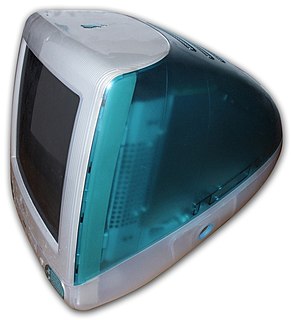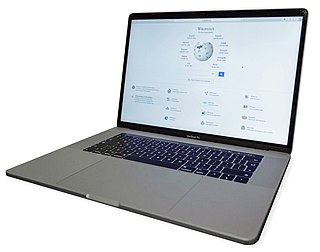
An identifier is a name that identifies either a unique object or a unique class of objects, where the "object" or class may be an idea, physical [countable] object, or physical [noncountable] substance. The abbreviation ID often refers to identity, identification, or an identifier. An identifier may be a word, number, letter, symbol, or any combination of those.

A vehicle identification number (VIN) is a unique code, including a serial number, used by the automotive industry to identify individual motor vehicles, towed vehicles, motorcycles, scooters and mopeds, as defined in ISO 3779 and ISO 4030.
In marketing, a product is an object or system made available for consumer use; it is anything that can be offered to a market to satisfy the desire or need of a customer. In retailing, products are often referred to as merchandise, and in manufacturing, products are bought as raw materials and then sold as finished goods. A service is also regarded to as a type of product.
An International Securities Identification Number (ISIN) uniquely identifies a security. Its structure is defined in ISO 6166. The ISIN code is a 12-character alphanumeric code that serves for uniform identification of a security through normalization of the assigned National Number, where one exists, at trading and settlement.
Xserve RAID is a mass-storage device that was offered by Apple Inc. Xserve RAID held up to 14 hot-swappable Ultra-ATA hard drives, and had a capacity of 10.5 TB when filled with 750 GB modules. Xserve RAID supported RAID levels of 0, 0+1, 1, 3 and 5 in hardware, hybrid RAID levels such as 10 and 50 could be created in software. It was rack-mountable and was 3U high.

The iMac G3, originally released as the iMac, is a series of Macintosh personal computers designed, manufactured, and sold by Apple Computer, Inc. from 1998 to 2003. Noted for its innovative enclosure via the use of translucent and brightly colored plastics, it was the first consumer-facing Apple product to debut under the recently returned interim CEO Steve Jobs. It was updated over time with new hardware and colors, until being supplanted by the iMac G4 and eMac in 2002.
Windows code pages are sets of characters or code pages used in Microsoft Windows from the 1980s and 1990s. Windows code pages were gradually superseded when Unicode was implemented in Windows, although they are still supported both within Windows and other platforms.

Hull number is a serial identification number given to a boat or ship. For the military, a lower number implies an older vessel. For civilian use, the HIN is used to trace the boat's history. The precise usage varies by country and type.

The MacBook Pro is a line of Macintosh portable computers introduced in January 2006, by Apple Inc. It is the higher-end model of the MacBook family, sitting above the consumer range MacBook Air, and is available in 13- and 15-inch screen sizes. A 17-inch version was available between April 2006 and June 2012.
This timeline of Macintosh models lists all major types of Macintosh computers produced by Apple Inc. in order of introduction date. Macintosh Performa models were often physically identical to other models, in which case they are omitted in favor of the identical twin. Also not listed are model numbers that identify software bundles. For example, the Performa 6115CD and 6116CD differed only in software and were identical to the Power Macintosh 6100, so only the 6100 is listed below. The Apple Network Server and Apple Lisa are included, as they filled high-end niches of the Macintosh line despite not directly running Mac OS.

The Mac Pro is a series of workstations and servers designed, manufactured and sold by Apple Inc. since 2006. The Mac Pro, in most configurations and in terms of speed and performance, is the most powerful computer that Apple offers. It is one of four desktop computers in the current Macintosh lineup, sitting above the consumer range Mac Mini and iMac, and serves as an easily-expandable alternative to the iMac Pro.
The Intel-based iMac is a family of Macintosh desktop computers designed, manufactured and sold by Apple Inc. since 2006. It is one of four desktop computers in the current Macintosh lineup, serving as an all-in-one alternative to the Mac Mini, and sits below the performance range iMac Pro and Mac Pro.

The iPod Classic is a portable media player created and formerly marketed by Apple Inc.

The MacBook Air is a line of laptop computers developed and manufactured by Apple Inc. It consists of a full-size keyboard, a machined aluminum case, and a thin light structure. The Air was originally positioned as a premium ultraportable positioned above the previous MacBook line. Since then, the Air has become Apple's entry-level laptop due to the original MacBook's discontinuation in 2011, as well as lowered prices on subsequent iterations. In the current product line, the MacBook Air sits below the performance range MacBook Pro.

The Mac mini is a desktop computer made by Apple Inc. It is one of four desktop computers in the current Macintosh lineup, serving as an alternative to the all-in-one iMac, and sits below the performance range iMac Pro and Mac Pro.

The sixth-generation iPod Touch (stylized and marketed as the iPod touch, and colloquially known as the iPod touch 6G, iPod touch 6, iPod touch or iPod 6, is a multipurpose handheld device designed and marketed by Apple Inc. with a touchscreen-based user interface. It is the successor to the iPod Touch, becoming the first major update to the iPod lineup in more than two and a half years. It was released on the online Apple Store on July 15, 2015, along with minor upgrades to the iPod Nano and iPod Shuffle. The iPod Touch was officially discontinued by Apple on May 28, 2019, with the release of its successor, the iPod Touch. Support ended for the 6th generation not long after its discontinuation, as it is incompatible with iOS 13.

The iPhone SE is a smartphone that was designed and marketed by Apple Inc. It is part of the ninth generation of the iPhone alongside the iPhone 6S. It was announced on March 21, 2016 at the Town Hall auditorium in the Apple Campus by Apple executive Greg Joswiak, with pre-orders beginning on March 24, 2016. It was officially released on March 31, 2016. It was re-released almost a year later on March 24, 2017 with larger storage capacities. The iPhone SE shares the same physical design and dimensions as the iPhone 5S, but has upgraded internal hardware, including the newer Apple A9 system-on-chip, greater battery capacity, and a 12-megapixel rear camera that can record 4K video. Along with the iPhone 6S and the iPhone X, the iPhone SE was discontinued by Apple on September 12, 2018.














